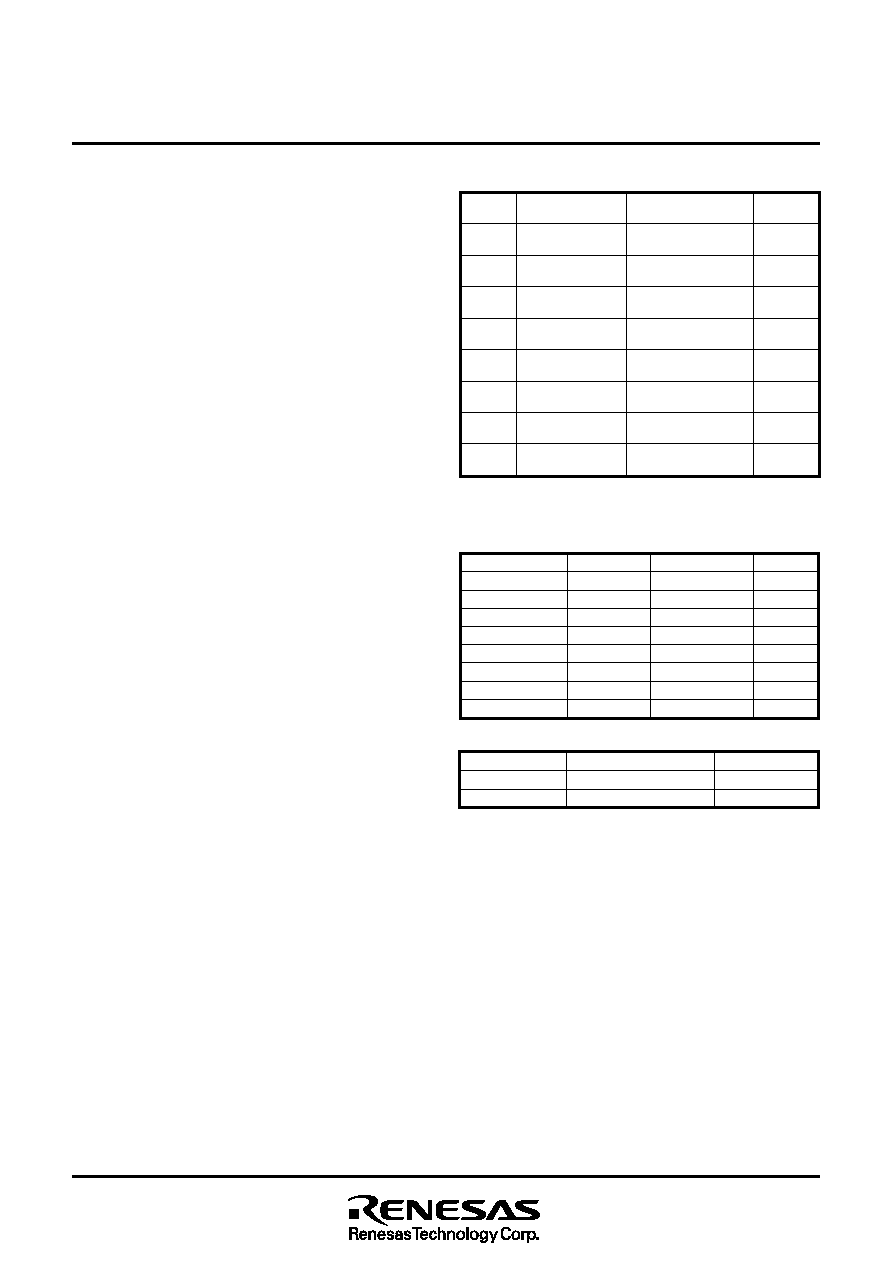- 您現(xiàn)在的位置:買賣IC網(wǎng) > PDF目錄69011 > M34513M2-XXXFP 4-BIT, MROM, 4.2 MHz, MICROCONTROLLER, PQFP32 PDF資料下載
參數(shù)資料
| 型號: | M34513M2-XXXFP |
| 元件分類: | 微控制器/微處理器 |
| 英文描述: | 4-BIT, MROM, 4.2 MHz, MICROCONTROLLER, PQFP32 |
| 封裝: | 7 X 7 MM, 0.80 MM PITCH, PLASTIC, LQFP-32 |
| 文件頁數(shù): | 14/97頁 |
| 文件大小: | 1276K |
| 代理商: | M34513M2-XXXFP |
第1頁第2頁第3頁第4頁第5頁第6頁第7頁第8頁第9頁第10頁第11頁第12頁第13頁當(dāng)前第14頁第15頁第16頁第17頁第18頁第19頁第20頁第21頁第22頁第23頁第24頁第25頁第26頁第27頁第28頁第29頁第30頁第31頁第32頁第33頁第34頁第35頁第36頁第37頁第38頁第39頁第40頁第41頁第42頁第43頁第44頁第45頁第46頁第47頁第48頁第49頁第50頁第51頁第52頁第53頁第54頁第55頁第56頁第57頁第58頁第59頁第60頁第61頁第62頁第63頁第64頁第65頁第66頁第67頁第68頁第69頁第70頁第71頁第72頁第73頁第74頁第75頁第76頁第77頁第78頁第79頁第80頁第81頁第82頁第83頁第84頁第85頁第86頁第87頁第88頁第89頁第90頁第91頁第92頁第93頁第94頁第95頁第96頁第97頁

20
4513/4514 Group
SINGLE-CHIP 4-BIT CMOS MICROCOMPUTER
MITSUBISHI MICROCOMPUTERS
INTERRUPT FUNCTION
The interrupt type is a vectored interrupt branching to an individual
address (interrupt address) according to each interrupt source. An
interrupt occurs when the following 3 conditions are satisfied.
An interrupt activated condition is satisfied (request flag = “1”)
Interrupt enable bit is enabled (“1”)
Interrupt enable flag is enabled (INTE = “1”)
Table 3 shows interrupt sources. (Refer to each interrupt request
flag for details of activated conditions.)
(1) Interrupt enable flag (INTE)
The interrupt enable flag (INTE) controls whether the every inter-
rupt enable/disable. Interrupts are enabled when INTE flag is set to
“1” with the EI instruction and disabled when INTE flag is cleared to
“0” with the DI instruction. When any interrupt occurs, the INTE flag
is automatically cleared to “0,” so that other interrupts are disabled
until the EI instruction is executed.
(2) Interrupt enable bit
Use an interrupt enable bit of interrupt control registers V1 and V2
to select the corresponding interrupt or skip instruction.
Table 4 shows the interrupt request flag, interrupt enable bit and
skip instruction.
Table 5 shows the interrupt enable bit function.
(3) Interrupt request flag
When the activated condition for each interrupt is satisfied, the cor-
responding interrupt request flag is set to “1.” Each interrupt
request flag is cleared to “0” when either;
an interrupt occurs, or
the next instruction is skipped with a skip instruction.
Each interrupt request flag is set when the activated condition is
satisfied even if the interrupt is disabled by the INTE flag or its in-
terrupt enable bit. Once set, the interrupt request flag retains set
until a clear condition is satisfied.
Accordingly, an interrupt occurs when the interrupt disable state is
released while the interrupt request flag is set.
If more than one interrupt request flag is set when the interrupt dis-
able state is released, the interrupt priority level is as follows
shown in Table 3.
Table 3 Interrupt sources
Activated condition
Level change of
INT0 pin
Level change of
INT1 pin
Timer 1 underflow
Timer 2 underflow
Timer 3 underflow
Timer 4 underflow
Completion of
A-D conversion
Completion of
serial I/O transfer
Priority
level
1
2
3
4
5
6
7
8
Interrupt name
External 0 interrupt
External 1 interrupt
Timer 1 interrupt
Timer 2 interrupt
Timer 3 interrupt
Timer 4 interrupt
A-D interrupt
Serial I/O interrupt
Request flag
EXF0
EXF1
T1F
T2F
T3F
T4F
ADF
SIOF
Interrupt name
External 0 interrupt
External 1 interrupt
Timer 1 interrupt
Timer 2 interrupt
Timer 3 interrupt
Timer 4 interrupt
A-D interrupt
Serial I/O interrupt
Table 5 Interrupt enable bit function
Occurrence of interrupt
Enabled
Disabled
Skip instruction
Invalid
Valid
Interrupt enable bit
1
0
Interrupt
address
Address 0
in page 1
Address 2
in page 1
Address 4
in page 1
Address 6
in page 1
Address 8
in page 1
Address A
in page 1
Address C
in page 1
Address E
in page 1
Table 4 Interrupt request flag, interrupt enable bit and skip in-
struction
Skip instruction
SNZ0
SNZ1
SNZT1
SNZT2
SNZT3
SNZT4
SNZAD
SNZSI
Enable bit
V10
V11
V12
V13
V20
V21
V22
V23
相關(guān)PDF資料 |
PDF描述 |
|---|---|
| M34515M4-XXXFP | 4-BIT, MROM, 4 MHz, MICROCONTROLLER, PDSO36 |
| M34524MC-XXXFP | 4-BIT, MROM, 6 MHz, MICROCONTROLLER, PQFP64 |
| M34524M8-XXXFP | 4-BIT, MROM, 6 MHz, MICROCONTROLLER, PQFP64 |
| M34524EDFP | 4-BIT, OTPROM, 6 MHz, MICROCONTROLLER, PQFP64 |
| M34551E8-XXXFP | 4-BIT, OTPROM, 8 MHz, MICROCONTROLLER, PQFP48 |
相關(guān)代理商/技術(shù)參數(shù) |
參數(shù)描述 |
|---|---|
| M34513M2-XXXSP | 制造商:RENESAS 制造商全稱:Renesas Technology Corp 功能描述:SINGLE-CHIP 4-BIT CMOS MICROCOMPUTER |
| M34513M4 | 制造商:MITSUBISHI 制造商全稱:Mitsubishi Electric Semiconductor 功能描述:SINGLE-CHIP 4-BIT CMOS MICROCOMPUTER |
| M34513M4-051FP | 制造商:MITSUBISHI 制造商全稱:Mitsubishi Electric Semiconductor 功能描述:SINGLE-CHIP 4-BIT CMOS MICROCOMPUTER |
| M34513M4-070FP | 制造商:MITSUBISHI 制造商全稱:Mitsubishi Electric Semiconductor 功能描述:SINGLE-CHIP 4-BIT CMOS MICROCOMPUTER |
| M34513M4-XXXFP | 制造商:RENESAS 制造商全稱:Renesas Technology Corp 功能描述:SINGLE-CHIP 4-BIT CMOS MICROCOMPUTER |
發(fā)布緊急采購,3分鐘左右您將得到回復(fù)。